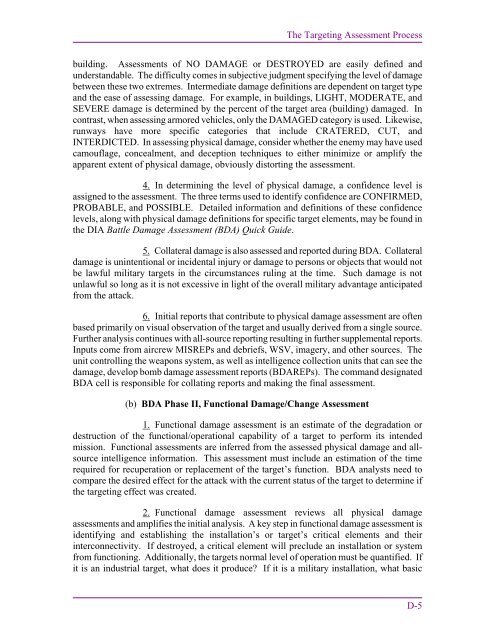Joint Targeting
1F87id9
1F87id9
You also want an ePaper? Increase the reach of your titles
YUMPU automatically turns print PDFs into web optimized ePapers that Google loves.
The <strong>Targeting</strong> Assessment Process<br />
building. Assessments of NO DAMAGE or DESTROYED are easily defined and<br />
understandable. The difficulty comes in subjective judgment specifying the level of damage<br />
between these two extremes. Intermediate damage definitions are dependent on target type<br />
and the ease of assessing damage. For example, in buildings, LIGHT, MODERATE, and<br />
SEVERE damage is determined by the percent of the target area (building) damaged. In<br />
contrast, when assessing armored vehicles, only the DAMAGED category is used. Likewise,<br />
runways have more specific categories that include CRATERED, CUT, and<br />
INTERDICTED. In assessing physical damage, consider whether the enemy may have used<br />
camouflage, concealment, and deception techniques to either minimize or amplify the<br />
apparent extent of physical damage, obviously distorting the assessment.<br />
4. In determining the level of physical damage, a confidence level is<br />
assigned to the assessment. The three terms used to identify confidence are CONFIRMED,<br />
PROBABLE, and POSSIBLE. Detailed information and definitions of these confidence<br />
levels, along with physical damage definitions for specific target elements, may be found in<br />
the DIA Battle Damage Assessment (BDA) Quick Guide.<br />
5. Collateral damage is also assessed and reported during BDA. Collateral<br />
damage is unintentional or incidental injury or damage to persons or objects that would not<br />
be lawful military targets in the circumstances ruling at the time. Such damage is not<br />
unlawful so long as it is not excessive in light of the overall military advantage anticipated<br />
from the attack.<br />
6. Initial reports that contribute to physical damage assessment are often<br />
based primarily on visual observation of the target and usually derived from a single source.<br />
Further analysis continues with all-source reporting resulting in further supplemental reports.<br />
Inputs come from aircrew MISREPs and debriefs, WSV, imagery, and other sources. The<br />
unit controlling the weapons system, as well as intelligence collection units that can see the<br />
damage, develop bomb damage assessment reports (BDAREPs). The command designated<br />
BDA cell is responsible for collating reports and making the final assessment.<br />
(b) BDA Phase II, Functional Damage/Change Assessment<br />
1. Functional damage assessment is an estimate of the degradation or<br />
destruction of the functional/operational capability of a target to perform its intended<br />
mission. Functional assessments are inferred from the assessed physical damage and allsource<br />
intelligence information. This assessment must include an estimation of the time<br />
required for recuperation or replacement of the target’s function. BDA analysts need to<br />
compare the desired effect for the attack with the current status of the target to determine if<br />
the targeting effect was created.<br />
2. Functional damage assessment reviews all physical damage<br />
assessments and amplifies the initial analysis. A key step in functional damage assessment is<br />
identifying and establishing the installation’s or target’s critical elements and their<br />
interconnectivity. If destroyed, a critical element will preclude an installation or system<br />
from functioning. Additionally, the targets normal level of operation must be quantified. If<br />
it is an industrial target, what does it produce? If it is a military installation, what basic<br />
D-5


